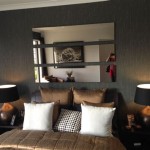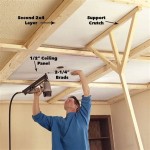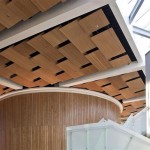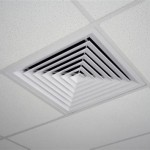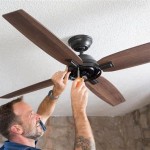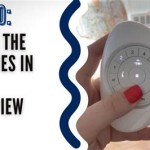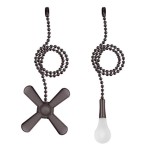How to Install LED Lights on Your Ceiling
Installing LED lights on the ceiling can dramatically transform a room's ambiance, energy efficiency, and overall aesthetic. This project, while manageable for many homeowners, requires careful planning, preparation, and execution. This article provides a comprehensive guide to safely and effectively install LED lights on your ceiling, covering various aspects from selecting the appropriate lighting type to securing the final connections.
Before commencing any electrical work, it is paramount to prioritize safety. Disconnect the power supply to the circuit at the breaker box before touching any wires. Use a voltage tester to confirm that the circuit is de-energized. This precaution is crucial to prevent electric shock and ensure a safe working environment. Wear appropriate safety glasses and gloves to protect yourself from debris and electrical hazards.
Planning and Preparation: Laying the Groundwork for Success
The planning stage is arguably the most important aspect of installing LED lights. A well-defined plan ensures a smooth installation process and minimizes potential errors. Key considerations include determining the type of LED lights, assessing the ceiling structure, and mapping out the wiring layout.
Selecting the appropriate type of LED lighting is crucial for achieving the desired effect. Several options are available, each with distinct characteristics and applications. These include:
- LED Strip Lights: Flexible and versatile, ideal for accent lighting, under-cabinet lighting, and creating indirect light sources. They are easily cut to length and come with adhesive backing for relatively simple installation.
- LED Panel Lights: Flat, energy-efficient lights that provide a uniform and diffused light distribution. Suitable for offices, kitchens, and areas requiring bright, consistent illumination.
- Recessed LED Lights (Can Lights): Offer a clean, integrated look, flush with the ceiling surface. They provide direct downlighting and are often used in living rooms, hallways, and bedrooms.
- LED Fixtures (Chandeliers, Pendants, Flush Mounts): These provide a decorative element in addition to illumination. Choose fixtures that complement the room's style and provide the appropriate amount of light.
Consider the room's dimensions, purpose, and existing décor when choosing the type of LED light. For example, a small bedroom might benefit from the subtle glow of LED strip lights along the perimeter, while a kitchen might require the brightness and functionality of recessed LED lights.
Assessing the ceiling structure is vital for ensuring a secure and stable installation. Determine the ceiling material (drywall, plaster, concrete) and identify the presence of any obstructions, such as pipes, wires, or HVAC ducts. For drywall or plaster ceilings, locate the ceiling joists using a stud finder. These joists provide structural support for mounting fixtures and securing wiring.
Mapping out the wiring layout is essential for a neat and organized installation. Plan the placement of each LED light and determine the optimal route for the wiring. Ensure that the wiring complies with local electrical codes and regulations. Consider the location of existing electrical outlets and switches. You may need to install new outlets or switches to accommodate the new lighting system. Draw a detailed diagram of the wiring layout, indicating the location of each light, switch, and junction box. This diagram will serve as a guide during the installation process.
Gather all necessary tools and materials before starting the installation. Essential tools include a voltage tester, wire stripper, wire cutter, screwdriver set, drill, stud finder, level, measuring tape, pencil, and safety glasses. Necessary materials include the chosen LED lights, wiring (ensure it is rated for the intended use), wire connectors, junction boxes, electrical tape, and mounting hardware. Having all the necessary tools and materials readily available will streamline the installation process and minimize delays.
The Installation Process: Step-by-Step Guide
The installation process varies depending on the type of LED lights being installed. However, some common steps apply to most installations. These include marking the location of the lights, preparing the wiring, installing the lights, and connecting the wiring.
Begin by marking the precise location of each LED light on the ceiling. Use a measuring tape and level to ensure accurate and consistent spacing. For recessed lights, use a hole saw of the appropriate size to cut the necessary openings in the ceiling. For strip lights or panel lights, mark the location for mounting brackets or adhesive strips.
Prepare the wiring by stripping the ends of the wires and attaching wire connectors. Ensure that the wires are properly grounded and that all connections are secure. Use wire connectors approved for electrical use. Carefully inspect each connection to ensure no loose strands are present.
Install the LED lights according to the manufacturer's instructions. For recessed lights, insert the fixture into the pre-cut hole and secure it using the provided clips or screws. For strip lights, peel off the adhesive backing and carefully apply the strip to the designated surface. For panel lights, mount the panel to the ceiling using screws or mounting brackets. Ensure that each light is securely mounted and properly aligned.
Connect the wiring to the LED lights, following the wiring diagram. Connect the black (hot) wire to the corresponding terminal on the light fixture, the white (neutral) wire to the neutral terminal, and the green or bare copper (ground) wire to the ground terminal. Use wire connectors to securely join the wires. Carefully tuck the wires into the junction box or fixture housing, ensuring that they are not pinched or strained. Secure the junction box cover or fixture housing to protect the wiring and prevent accidental contact.
After all connections are made, double-check the wiring to ensure that everything is properly connected and secured. Use a voltage tester to verify that the circuit is not energized before proceeding with the final steps. Carefully inspect each connection for any loose wires or exposed conductors.
Restore power to the circuit at the breaker box. Test the lights to ensure that they are functioning properly. If any lights do not turn on, immediately disconnect the power and re-examine the wiring. Once all lights are functioning correctly, you can adjust the light levels or color temperature to achieve the desired effect. Clean up any debris or tools from the work area. Properly dispose of any waste materials, such as wire scraps or packaging.
Troubleshooting Common Issues: Addressing Potential Problems
Even with careful planning and execution, some issues may arise during or after the installation of LED lights. Common problems include lights not turning on, flickering, or overheating. Understanding these issues and their potential causes can help you troubleshoot and resolve them effectively.
If the LED lights do not turn on after restoring power, the first step is to verify that the breaker is not tripped. Check the breaker box and reset any tripped breakers. If the breaker continues to trip, there may be a short circuit in the wiring. Disconnect the power and carefully inspect the wiring for any exposed conductors or damaged insulation. If the breaker is not tripped, check the wiring connections to ensure that they are secure and properly connected. Use a voltage tester to confirm that power is reaching the light fixture.
Flickering LED lights can be caused by several factors, including loose wiring connections, incompatible dimmers, or voltage fluctuations. Check all wiring connections to ensure that they are tight and secure. If you are using a dimmer switch, ensure that it is compatible with LED lights. Some older dimmer switches are not designed to work with LEDs and can cause flickering or buzzing. If the flickering persists, try replacing the dimmer switch with an LED-compatible model. Voltage fluctuations can also cause flickering, especially in older homes with outdated electrical systems. Consider consulting a qualified electrician to address any underlying electrical issues.
Overheating LED lights can be a sign of a serious problem, such as improper ventilation, excessive current draw, or a faulty fixture. Ensure that the LED lights have adequate ventilation. Recessed lights, in particular, require sufficient clearance around the housing to dissipate heat. Avoid covering the lights with insulation or other materials that could trap heat. If the lights are drawing excessive current, there may be a problem with the wiring or the fixture itself. Consult a qualified electrician to diagnose and repair the problem. A faulty fixture can also cause overheating. If you suspect that the fixture is defective, contact the manufacturer for warranty information or replacement.
In any situation where you are uncomfortable or unsure about the electrical work, it is always best to consult a qualified electrician. A licensed electrician has the training and experience to safely and effectively install and repair electrical systems. They can also ensure that your installation complies with all local codes and regulations.

6 Steps How To Install Led Strip Lights On Ceiling

Led Strip Lights Installation False Ceiling Pop

How To Install Led Strip Lights 7 Easy Steps

How To Hang Led Lights In The Bedroom A Step By Guide

Diy Ceiling Led Lights Installation Builds

How To Install Led Flat Panel Light Ox Lighting

How To Install Led Strip Lights 7 Easy Steps Lighting Installing Bedroom

How To Install Elegant Cove Lighting From Crown Molding

How To Install The Led Strip Light On Ceiling

How To Choose The Best Led Strip Lights For Ceiling
Related Posts

